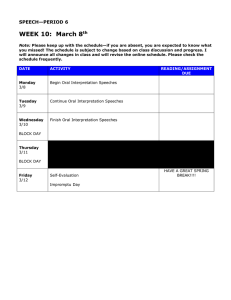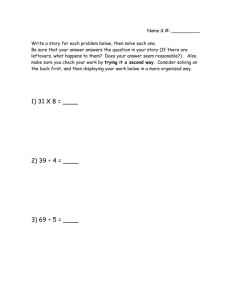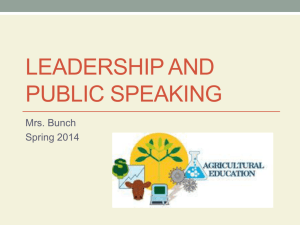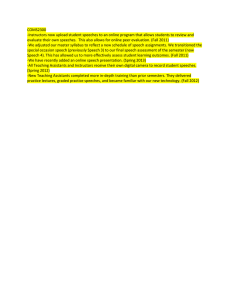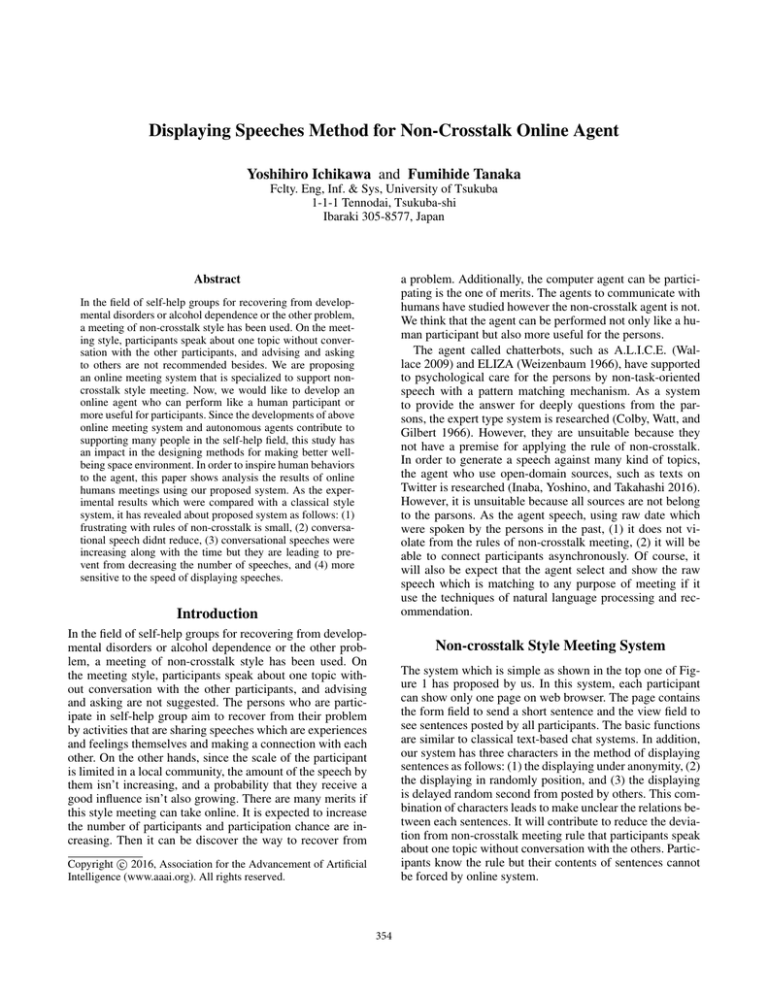
Displaying Speeches Method for Non-Crosstalk Online Agent
Yoshihiro Ichikawa and Fumihide Tanaka
Fclty. Eng, Inf. & Sys, University of Tsukuba
1-1-1 Tennodai, Tsukuba-shi
Ibaraki 305-8577, Japan
a problem. Additionally, the computer agent can be participating is the one of merits. The agents to communicate with
humans have studied however the non-crosstalk agent is not.
We think that the agent can be performed not only like a human participant but also more useful for the persons.
The agent called chatterbots, such as A.L.I.C.E. (Wallace 2009) and ELIZA (Weizenbaum 1966), have supported
to psychological care for the persons by non-task-oriented
speech with a pattern matching mechanism. As a system
to provide the answer for deeply questions from the parsons, the expert type system is researched (Colby, Watt, and
Gilbert 1966). However, they are unsuitable because they
not have a premise for applying the rule of non-crosstalk.
In order to generate a speech against many kind of topics,
the agent who use open-domain sources, such as texts on
Twitter is researched (Inaba, Yoshino, and Takahashi 2016).
However, it is unsuitable because all sources are not belong
to the parsons. As the agent speech, using raw date which
were spoken by the persons in the past, (1) it does not violate from the rules of non-crosstalk meeting, (2) it will be
able to connect participants asynchronously. Of course, it
will also be expect that the agent select and show the raw
speech which is matching to any purpose of meeting if it
use the techniques of natural language processing and recommendation.
Abstract
In the field of self-help groups for recovering from developmental disorders or alcohol dependence or the other problem,
a meeting of non-crosstalk style has been used. On the meeting style, participants speak about one topic without conversation with the other participants, and advising and asking
to others are not recommended besides. We are proposing
an online meeting system that is specialized to support noncrosstalk style meeting. Now, we would like to develop an
online agent who can perform like a human participant or
more useful for participants. Since the developments of above
online meeting system and autonomous agents contribute to
supporting many people in the self-help field, this study has
an impact in the designing methods for making better wellbeing space environment. In order to inspire human behaviors
to the agent, this paper shows analysis the results of online
humans meetings using our proposed system. As the experimental results which were compared with a classical style
system, it has revealed about proposed system as follows: (1)
frustrating with rules of non-crosstalk is small, (2) conversational speech didnt reduce, (3) conversational speeches were
increasing along with the time but they are leading to prevent from decreasing the number of speeches, and (4) more
sensitive to the speed of displaying speeches.
Introduction
In the field of self-help groups for recovering from developmental disorders or alcohol dependence or the other problem, a meeting of non-crosstalk style has been used. On
the meeting style, participants speak about one topic without conversation with the other participants, and advising
and asking are not suggested. The persons who are participate in self-help group aim to recover from their problem
by activities that are sharing speeches which are experiences
and feelings themselves and making a connection with each
other. On the other hands, since the scale of the participant
is limited in a local community, the amount of the speech by
them isn’t increasing, and a probability that they receive a
good influence isn’t also growing. There are many merits if
this style meeting can take online. It is expected to increase
the number of participants and participation chance are increasing. Then it can be discover the way to recover from
Non-crosstalk Style Meeting System
The system which is simple as shown in the top one of Figure 1 has proposed by us. In this system, each participant
can show only one page on web browser. The page contains
the form field to send a short sentence and the view field to
see sentences posted by all participants. The basic functions
are similar to classical text-based chat systems. In addition,
our system has three characters in the method of displaying
sentences as follows: (1) the displaying under anonymity, (2)
the displaying in randomly position, and (3) the displaying
is delayed random second from posted by others. This combination of characters leads to make unclear the relations between each sentences. It will contribute to reduce the deviation from non-crosstalk meeting rule that participants speak
about one topic without conversation with the others. Participants know the rule but their contents of sentences cannot
be forced by online system.
c 2016, Association for the Advancement of Artificial
Copyright Intelligence (www.aaai.org). All rights reserved.
354
Figure 2: The total counts of non-crosstalk speeches and
conversational speeches along the time axis in all meetings.
Meetings were anytime starting at zero minutes and changing a topic at eighteen minutes.
Figure 1: The top one shows that is our proposed system;
the bottom one shows that is a comparison system which is
imitating a classical displaying style called timeline.
agent who increases conversational sentence along with the
time will be seemed to be a human. The opinions which is
felt that the speed of displaying speeches is fast and feeling
busy was given by proposed system users. So, it is preferred
that the agent is able to pay attention so that the own speech
doesn’t become a fast.
Experiment
This experiment aims to analyze the participants impressions when using a system and the contents of their
speeches. The participants are eighteen persons who were
gathered by employment offers for our university students,
male and female. Three meetings held with three groups.
Each meeting group consists of the six persons who answered so that have a serious problem about the same matter,
and then they discussed about two topics of that matters. It
means that the group is regarded as hypothetical self-help
group. To compare the proposed displaying style and classical one, although six participants presented at the same
meeting, three of them used proposed interface and remaining three persons used classical style one as shown in the
bottom one of Figure 1.
To develop the non-crosstalk online agent, this paper showed
the analysis of meeting that was held on our proposed system which is specialized to support non-crosstalk style meeting. As the experimental result, it has revealed about agent
requirements as follows: (1) the agent who increases conversational sentence along with the time will be seemed to
be a human, (2) the agent is preferred that it is able to pay
attention so that the own speech doesn’t become a fast.
As our future works, we implement the agent to our system and apply to the field of actual self-help groups.
Results and Discussion
This work was supported by JSPS KAKENHI Grant Number 24119003.
Conclusion
Acknowledgments
As the questionnaire answer, the opinion which would like
to do more conversational communication was given by the
participants who was using conventional interface. Since
this can regard that they are felt frastration with the rules
of non-crosstalk, the proposed system contribute to provide
the environment that participants tend to speak without conversation with the others. When all speeches of the meetings are categorized, on average at about 50% is belong
to non-crosstalk speech. The difference of two systems results is few. Note that remaining 50% containing conventional speeches, monologue, and etc. However, the infection
of proposed system users from others speech was small. This
result give us an expectation that proposed system leads to
reduce a feeling of strangeness for agent. As shown in Figure 2, the number of conversational speeches were increasing along with the time. In other words, it is thought that the
References
Colby, K. M.; Watt, J. B.; and Gilbert, J. P. 1966. A computer method of psychotherapy: Preliminary communication. Journal of Nervous and Mental Disease 142(2):148–
152.
Inaba, M.; Yoshino, Y.; and Takahashi, K. 2016. Open domain monologue generation for speaking-oriented dialogue
systems. Transactions of the Japanese Society for Artificial
Intelligence 31(1).
Wallace, R. S. 2009. The Autonomy of A.L.I.C.E. Parsing
the Turing Test. Springer. chapter 13, 181–210.
Weizenbaum, J. 1966. Eliza - a computer program for the
study of natural language communication between man and
machine. Communications of the ACM 9(1):36–45.
355

